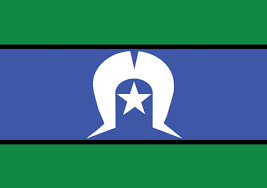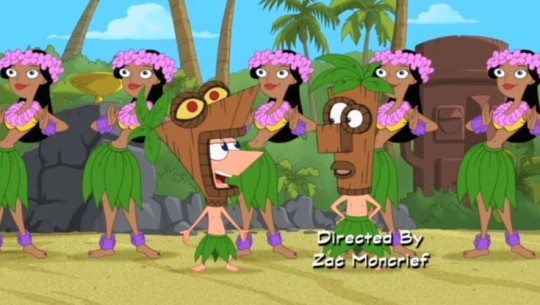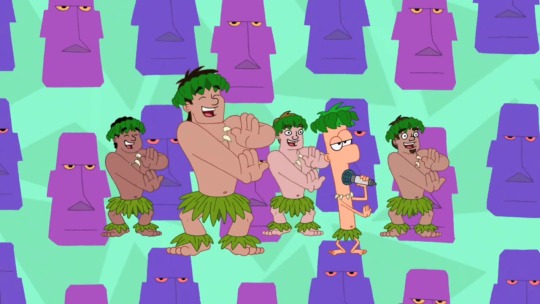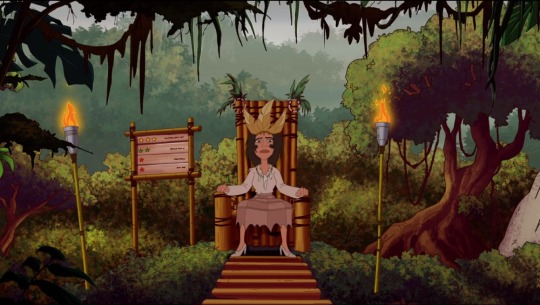#Torres strait islands
Explore tagged Tumblr posts
Photo

Dogai, the 226th Known One.
Suggested by @thecreaturecodex.
#Dogai#hag#Torres Strait Islands#folklore#Oceania#more lore is coming with their post !! :D#thecreaturecodex#suggestion#god i love working on these ahah#that suggestion actually helped my getting back on the chimeras#flying fox#bat#bird#chimpanzee#monkey#chimera#monster#bestiary#creature design#ink#the Known Ones#904#octem 113#aqva 4
118 notes
·
View notes
Text
Skulls were the main trading currency used by the Torres Strait Islander people with their Papuan New Guinean neighbours. These trading skulls were acquired in battle and through raiding parties to other islands and the Australian mainland. The skulls of family members, those of important leaders and revered warriors were not traded. Skulls were used in various rituals.
Byerb Ibaik refers to the scraping of the bone above the eye sockets of a skull that belonged to a legendary warrior. A paste was made of the scrapings and fed to young boy babies to imbue in them the skill, courage and other attributes that contributed to the warrior’s fame during his lifetime.
2 notes
·
View notes
Text
The Torres Strait Islands’ conversion to Christianity essentially brought an end to cultural traditions such as witchcraft and headhunting; the ritual practice of taking the head of one’s enemy with a bamboo knife known as an upi having earned Islanders a feared reputation among early European explorers to the region. Christianity has also been credited by historians for tempering inter-island warfare, yet the warrior culture of the Torres Strait continues to run deep.
#torres strait islanders#headhunters#Witchcraft#black culture#Headhunter#Torres strait islands#Culture#My culture#The coming of the light#Black magic#Traditional
1 note
·
View note
Text
So weird take here; but it seems to come from this weird idea that all Indigenous peoples were living hard lives - barely surviving and so had no time for leisure?
I’m not an expert but feels like a good place to show some of the things I’ve learned about leisure and recreation in Australia to tackle the root issue here, instead of ‘hiking specifically bad’.
*Nothing is super comprehensive here, but a good start!
Aboriginal and Torres Strait Islander Leisure and Recreation
Traditional Games played by Children in Australia (With videos; QLD primarily)
Even more Games played by Children in Australia (NSW primarily)
More traditional games played by Children in Australia (PDF)
The Bunya Festival in in the Bunya Mountains in Queensland, where the Kabi Kabi and Wakka Wakka people would host an event where people on the east coast of Australia would gather to celebrate the harvest of Bunya which occurred once every three years. These gatherings would bring huge groups of people and different nations from as far as Victoria and Western Queensland to join the festivities. In addition to the harvest, the event including bowls, running races, spear and boomerang throwing games, and a huge array of other things.
Marngrook - A link to the history of the sport, which arguably, forms the basis for modern AFL in Australia.
I wanted to highlight the above as a starting place for the Aussies that follow me and to highlight that leisure and recreation are part of human history! Every culture has multiple forms of recreation - and erasing recreation and leisure is often a feature of colonialism, not a bug. The below is something that I wouldn’t describe as purely recreation, but something tangentially related:
Songlines, for example are the Aboriginal walking routes that crossed the country, linking important sites and locations.
Someone way more informed than me can talk about culture and hiking specifically in Australia - because there’s so much that I’m just not qualified to talk on!

what level of racism is she on
#Please correct me if I’m in error#Australia#colonialism#recreation#leisure#Aboriginal Australia#Torres Strait Islands#info dump
965 notes
·
View notes
Link
Climate advocate and a traditional owner in Torres Strait Islands, Mr Yessie Mosby, says its deeply saddening to see the impact of climate change on his community and is calling on global action.
#climate change#environment#climate action#Torres Strait Islands#Australia#news#via Triple A#world news
0 notes
Text
Skipping ALL things in my queue, and all the asks in my ask box, to tell y'all about THIS that came out a few hours ago. I cannot express how excited I am about this information finally being published.
Its not the first evidence of pottery technologies found in Australia, but the artefacts that have been found at the Lizard Island group in the past havent necessarily been datable. Evidence of pottery in the Torres Strait was also found in the early 2000s, and its been analysed to be evidence of trade with Papua New Guinea (who have an AMAZING history of pottery technology).
To our amazement, around 40cm below the surface we began to find pieces of pottery among the shells in the excavation. We knew this was a big deal. We carefully bagged each piece of pottery and mapped where each sherd came from, and kept digging.
But as of now, there's officially dated evidence for locally made pottery in Australia, of at least 1800 years. Not only outside the Torres Straight, but 300km south. Not only 1800+ years old, but also pre-dating the original known dates for Torres Straight Islands pottery, suggesting the possibility of even earlier pottery technology trade with PNG. AND ITS DECORATED.
Radiocarbon dating of charcoal and shells found close to the pottery shows that it is between 2,950 and 1,815 years old, making it the earliest securely dated pottery ever found in Australia. Analysis of the clays and tempers shows that all of the pottery was likely made on Jiigurru.
The pottery stopped at about 80cm depth, with 82 pieces of pottery in total. Most are very small, with an average length of just 18 millimetres. The pottery assemblage includes rim and neck pieces and some of the pottery is decorated with pigment and incised lines.
#GUYS IM SO EXCITED#IVE BEEN WAITING FOR THIS#archaeology#australia#Aboriginal and Torres Strait Islander peoples#this is literally SO huge#they let a mouse do archaeology?#Indigenous peoples
611 notes
·
View notes
Text
For #WorldDugongDay:



Alick Tipoti (Torres Strait: Badhu Island, Kala Lagaw Ya, b.1975)
Kisay Dhangal, 2016
Sculpture, bronze with mother-of-pearl inlay
194 × 202 × 102 cm, 280 kg
Australian National Maritime Museum 00054952
"Inscribed with traditional motifs and pearl shell, Kisay Dhangal reflects the life cycle and feeding patterns of the dhangal (dugong) in the Torres Strait Islands. The dhangal is captured in the position known as San Tidayk, in Kala Lagaw Ya language which marks the moment the mammal flips its tail to dive down and graze on the sea grass beds. A marine dust trail between the tail and figure of the moon emphasize how lunar cycles determine dugong feeding and mating habits."
#Alick Tipoti#animals in art#animal holiday#sculpture#metalwork#bronze#Indigenous art#Australian art#Torres Strait Islander art#contemporary art#Australian National Maritime Museum#dugong#World Dugong Day#marine mammals#Sirenians#ethnozoology
164 notes
·
View notes
Text
every monster high fancast is just:
Frankie: white woman
Draculaura: white woman
Cleo: white woman
Lagoona: white woman
Abbey: white woman
Ghoulia: white woman
Clawdeen: Zendaya
#my post#what is wrong with y'all#Cleo is Egyptian#she isn't cleopatra so don't try that stupid “but cleopatra's macedonian” cause cleo ain't her#Lagoona is Aboriginal or a Torres Strait Islander#because are you really suggesting the sea also got colonised?#Abbey is DESI (or Chinese)#girl is from the Himalayas#Clawdeen is a dark-skinned woman#that is important to her character#also do y'all not know any other black actresses? seriously?#monster high#monster high fancasts#mh#ghoulia yelps#abbey bominable#clawdeen wolf#lagoona blue#cleo de nile#frankie stein#draculaura
112 notes
·
View notes
Text

for those who don't know: this is the Aboriginal flag.
the black represents the colour of the skin of the people
the red represents the red earth and the spiritual connection to it, as well as the red ochre used in ceremonies
the yellow circle represents the sun, the giver of life

this is the Torres Strait Islander flag, a flag which is just as important, signifying another group of Indigenous australians
the green represents the land, the blue represents the sea
the black lines separating them represents the Torres Strait Islander people
the centre of the flag has a white dhari, a type of headdress
the white star underneath it symbolizes peace, and the 5 points represent the 5 island groups in the Torres Strait
please correct me if you believe any of this information is wrong
#i know only my australian mutuals will be alive right now but i think this might be important for some of us too#im sure yall knew about the Aboriginal flag#but i personally didn't know the meaning of the Torres Strait Islander flag. had to google and read about it#but dw i read like 3 different websites which all seemed to agree on those facts#so i think i got it right#but im sure my qlder followers would know more than me and i would gladly be educated
171 notes
·
View notes
Photo

NAIDOC Week
It’s NAIDOC Week in Australia, a week acknowledging and celebrating Aboriginal and Torres Strait Islander peoples and culture.
If you’d like to learn a bit about Aboriginal and Torres Strait Islander queer history, we’ve put together a few links to get you started.
Peopling the Empty Mirror: The Prospects for Lesbian and Gay Aboriginal History by the Gays and Lesbians Aboriginal Alliance (1994) - an essay reviewing literature on Aboriginal sexuality, and discussing future of Aboriginal queer history
ATSI Rainbow Archive curated by Andrew Farrell - an online archive active from 2014 to 2021, cataloguing links from across the internet referencing queer Aboriginal and Torres Strait Islander experiences.
What do we know about queer Indigenous history? by James Findley (2018) - an article in which Findley speaks to queer Aboriginal and Torres Strait Islander people about their understandings and experiences of queer Indigenous history.
Colouring the Rainbow: Blak Queer and Trans Perspectives edited by Dino Hodge (2015) - an anthology of essays and personal stories by twenty-two First Nations people exploring identity, culture and queerness.
We are far from experts so if you have links to more sources feel free to add them.
#naidoc week#naidoc#aboriginal history#torres strait islander history#atsi history#australia#lgbt#lgbtq#queer#queer histroy
470 notes
·
View notes
Text
always was, always will be aboriginal land ❤️💛🖤
#dont know how many aussies follow me but its jmportant#for those who arent australia!!#today is invasion day otherwise known as australia#its a celebration of the mass genocide of the aboriginal and torres strait islander people#(the owners of aussie land)#weve also very recently lost a vote to give aboriginal people a say in what happens to that land#thankfully the protests all over the country were huge#ive just gotten home from one that had tens of thousands of people marching through meanjin#if youd like some links to support indigenous owned businesses (v important to do especially today)#feel free to dm me#australia#invasion day#australia day#jan 26th#change the date#vote yes#land back
86 notes
·
View notes
Text

Desirai.art for NAIDOC Week 2024
#desirai art#blak artist#blak australia#indigenous art#aboriginal#torres strait islanders#NAIDOC#NAIDOC week#keep the fire burning#aboriginal artist#First Nations art
44 notes
·
View notes
Text

My pearl skull necklace represents my Island Home. The pearl is for the pearl diving industry and the skull is for the headhunting. 💀
#Torres strait islander#Skulls#Pearls#Necklace#torres strait islanders#Torres strait islands#Rare#jewellery#Mine#photography
0 notes
Text
has anyone done an aboriginal miku. i really want to see that. do i have to do it myself.
18 notes
·
View notes
Text
pnf revival hope: no more of this shit








#phineas and ferb#milo murphy's law#dwampyverse#racism cw#anti native racism#anti indigenous racism#//there is. a lot to unpack here#//i know that dwampy didn't invent associating *every* island culture together with The Beach#//that's been a thing in the US since at least the late 1930s#//but what really pisses me off is the weird Island Tribe stuff#//especially the cannibal tribe 'gag' in the Island of Lost Dakotas#//**where do you think the cultural set up for that gag comes from?**#//racist stereotypes about polynesians maori torres strait islanders papuans aboriginal australians#//pretty much every culture that gets strip mined for The Island Aesthetic™#//i just. don't want this kind of shit in cartoons anymore yknow#//we KNOW stereotyping and using native american tribes as aesthetics or cannibals is bad#//and it happens a lot less nowadays esp in tv animation#//but some people do the same shit with island nations and it gets a pass for some reason. its really gross#//(and that's not even getting to the weird treatment of asian cultures in the dwampyverse)#//(but there's a photo and tag limit so. that's for another time)
14 notes
·
View notes
Text
I've seen some misinformation spreading around tumblr about the Australian Voice referendum to be held this Saturday, 14 October 2023, so here are some actual facts about what it is and why Australians should PLEASE vote YES.
So, what is the referendum question?
The referendum question is about recognising Indigenous Australians in the Constitution, and setting up a body to be known as the Aboriginal and Torres Strait Islander Voice, so that Indigenous representatives have the right to provide advice to government about decisions that affect Indigenous people.
Here’s the actual referendum question:
A Proposed Law: to alter the Constitution to recognise the First Peoples of Australia by establishing an Aboriginal and Torres Strait Islander Voice. Do you approve this proposed alteration?
The new chapter and section to be added to the constitution are:
Chapter IX Recognition of Aboriginal and Torres Strait Islander Peoples
S 129 Aboriginal and Torres Strait Islander Voice
In recognition of Aboriginal and Torres Strait Islander peoples as the First Peoples of Australia:
1. There shall be a body, to be called the Aboriginal and Torres Strait Islander Voice;
2. The Aboriginal and Torres Strait Islander Voice may make representations to the Parliament and the Executive Government of the Commonwealth on matters relating to Aboriginal and Torres Strait Islander peoples;
3. The Parliament shall, subject to this Constitution, have power to make laws with respect to matters relating to the Aboriginal and Torres Strait Islander Voice, including its composition, functions, powers and procedures.
Source and more info
That’s it. That’s all it is.
The No campaign is spreading lies about the Voice, suggesting that it will somehow take rights or property away from non-Indigenous Australians. They’ve also been using social media - and some elements of mainstream media - to stir up fear and racism, using tactics with a vibe that will be all too familiar to our American friends who have lived through Trump, or our British friends who have been through Brexit.
Here are a few simple facts to counter some of the misinformation that's out there.
Why do we need a body like the Voice?
Indigenous people experience a level of disadvantage that applies to no other group of Australians. As the Prime Minister has said on numerous occasions, a young Indigenous man in this country today is more likely to go to jail than to go to university. Meanwhile, the periodic closing the gap reports show that Australian governments continue to fail in their aim for Indigenous Australians’ health and life expectancy to be equal to that of other Australians.
These sorts of outcomes are typical of a system that has always been about doing things to Indigenous people, rather than with them. Indigenous people need to be in the room when decisions are made about matters that affect them.
So yeah, we need an advisory body that has the ear of politicians. Seems simple enough, so why not just legislate it?
That’s the thing: we’ve already tried that.
We need an advisory body like the Voice to be enshrined in the Constitution because we’ve HAD advisory bodies before – bodies like the former Aboriginal and Torres Strait Islander Commission (ATSIC). ATSIC was abolished in 2005 by a government that was hostile to ATSIC’s aims – something that government could easily do since there was no obligation for a body like that to exist. Other similar bodies have gone the same way.
Putting the Voice in the constitution means that it will always exist. The actual decision-making power continues to reside with our elected politicians, but having the Voice means that they will be obligated to listen to the perspective and suggestions of Indigenous representatives before they (the politicians) make decisions affecting Indigenous people.
The politicians will still have the power to legislate the details of how the Voice works, just like any other body set up under legislation - but once it's in the constitution, they don't get to decide whether it exists or not.
Where did the idea for the Voice come from?
Indigenous people have been calling for something like the Voice since the 1920s, but the current proposition originated in the Uluru Statement from the Heart. This is a petition created by Indigenous delegates to the First Nations National Constitutional Convention held at Uluru in 2017. The Uluru statement from the heart is only 439 words, but they’re very powerful words. Read it here
So if you hear the No campaign trying to say that the idea for the Voice comes from Canberra or from politicians: no, it doesn’t. It comes from Uluru, in central Australia, and it comes from a request by representatives of a large number of Indigenous people. The government is responding to that request by holding this referendum.
Do all Indigenous Australians support the Voice?
Have you ever known any group of people that share 100% support for anything? Of course there isn’t agreement by every single Indigenous person that this is the right way to proceed. HOWEVER, that said, polling shows that around 80% of Indigenous Australians support the Voice, and of the remaining approximately 20%, many don’t support the Voice because they believe it doesn’t go far enough. Some want a treaty before anything else.
But you wouldn’t know that by the way the Australian media has reported the campaign.
I’m not going to repeat that No campaign slogan. If you’ve watched or read any reporting about this issue, you know the one I mean. The one that panders to ignorance and fear.
Instead, I’m just going to say: if you don’t know, FIND OUT. And then VOTE YES.
83 notes
·
View notes